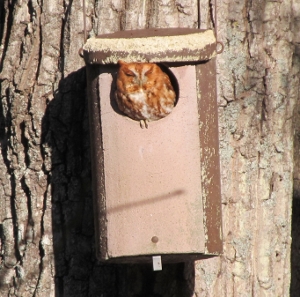
The Eastern Screech Owl (Megascops asio) is only about 8½ inches long. Most Virginia screech owls are red, but you do occasionally see gray-brown, and rarely chocolate-brown, individuals. Despite its very small size and its mostly nocturnal (nighttime) activities, this is probably the easiest owl for anyone to actually get to see.
As soon as the weather cools down in fall, screech owls start spending daylight hours inside natural tree cavities or wildlife boxes. If you’ve heard screech owls in your area and you put up a box specifically sized for these little birds of prey, you are very likely to attract a screech owl.
Bird-supply stores may have premade owl boxes in stock or they might be able to order one for you. Or you can build your own owl box by locating plans in a book on how to make bird boxes or by contacting your local extension agent or the Department of Game & Inland Fisheries.
Winter is a great time to make bird boxes since it’s an indoor activity! When you’ve completed your box, screw it onto a tree (it won’t hurt the tree) about 12 feet above the ground.
The box should be facing an open area where prey is available for the bird to observe and feed upon, but it should be located within a wooded area. Placing the box upon a tree about 10 to 30 feet from the edge of a clearing (i.e., a field or nature-friendly yard) is ideal.
The wonderful aspect of having an owl box on your property is that the owl will often perch in the cavity opening (box entrance-hole) during the afternoon if the area is in sunshine, giving you the opportunity to get a good look at it!
During winter the Eastern Screech Owl feeds mostly from dusk to dawn upon small mammals (such as mice and shrews) and birds. During the warmer months it also takes insects and other invertebrates (animals without a backbone), reptiles, amphibians, and crayfish (an aquatic crustacean).
When it feeds, a screech owl helps to limit populations of its prey species to sustainable levels. The little owl is itself a source of food for other animals, such as the much larger Great Horned and Barred Owls.
Although Eastern Screech Owls hunt mostly after dark, they will sometimes hunt in broad daylight when it is quite chilly.
One very cold winter day I watched a screech owl perched in the entrance hole of one of my wildlife boxes as it watched a Dark-eyed Junco foraging below. Suddenly the owl flew down, grabbed the junco in its talons, and flew back up to the box, bringing the unwary bird inside.
This kind of activity makes some people decide against enticing owls to their properties. But although it’s hard for us to watch predation taking place, we need to remember that every kind of creature needs to have its population kept in check. The Earth is finite which means resources, such as food and water, are limited. Predation is the means by which Mother Nature accomplishes sustainable populations.
Nature-friendly garden tip: If you are building a box for screech owls, make the entrance hole 4½ inches in diameter. It’s difficult for an owl to perch in a box with only a 3-inch entrance hole as is usually recommended. For almost 3 decades, the owls in my yard have preferred, and successfully nested in, the boxes with larger holes.
Naturalist Marlene A. Condon is the author/photographer of The Nature-friendly Garden: Creating a Backyard Haven for Plants, Wildlife, and People (Stackpole Books; information at www.marlenecondon.com). If you have a question about plants or animals, or gardening in a nature-friendly manner, send it to [email protected] and please watch for an answer in this paper.

